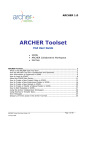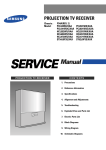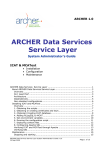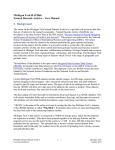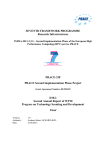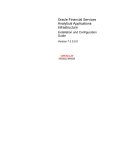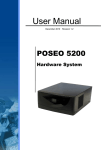Download System Administrator`s Guide
Transcript
ARCHER 1.0 XDMS System Administrator’s Guide • Installation • Configuration • Maintenance XDMS .......................................................................................................... 1 Introduction .............................................................................................. 3 Intended audience .................................................................................. 3 Overview............................................................................................... 3 Warning and disclaimer ........................................................................... 3 Configuration ......................................................................................... 4 Authentication........................................................................................ 5 Do I need a handle server? ...................................................................... 5 Do I need a Fedora repository?................................................................. 5 Prerequisites.......................................................................................... 5 Installation workflow............................................................................... 6 Preparing the host environment ................................................................... 7 1. Create a team leader group on the SRB ................................................. 7 2. Creating collections on your SRB........................................................... 7 3. Creating the ICAT database.................................................................. 8 4. Building XDMS.................................................................................... 9 5. Creating the ICAT database structure .................................................... 9 Building XDMS......................................................................................... 11 XDMS System Administrator’s Guide v1.0 30 Sept 2008 Page 1 of 24 Overview............................................................................................. 11 Prerequisites........................................................................................ 11 1. Obtaining the XDMS source code......................................................... 11 2. Configuring ddm-icat-applicationContext.xml ........................................ 11 3. Configuring xdms.properties............................................................... 12 3a. Configuring the SRB section.............................................................. 12 3b. Configuring the MyProxy section........................................................ 13 3c. Configuring the Shibboleth section ..................................................... 13 3d. Configuring the handle server section ................................................ 14 3e. Configuring the SMTP server section .................................................. 15 3f. Configuring the UQ Metadata Editor section ......................................... 15 3g. Configuring the tree panel titles and labels section............................... 15 3h. Configuring the Fedora section.......................................................... 16 3i. Configuring dataset packaging settings ............................................... 16 4. Configuring database entries .............................................................. 16 5. Building XDMS.................................................................................. 16 Deploying XDMS ...................................................................................... 18 Before you begin .................................................................................. 18 1. Deploying MDE ................................................................................. 18 2. Registering the JNDI resource for MDE................................................. 18 3. Deploying XDMS ............................................................................... 19 4. (Optional) Tweaking Tomcat............................................................... 19 5. Verifying.......................................................................................... 19 Troubleshooting ................................................................................... 19 Maintaining XDMS.................................................................................... 21 Stopping and starting............................................................................ 21 Logging............................................................................................... 21 Configuring.......................................................................................... 21 Stop Tomcat, redeploy the .war file, then restart Tomcat, as described in “. Error! Bookmark not defined. Installing custom schema templates........................................................ 22 Creating other groups ........................................................................... 23 Development status ................................................................................. 24 XDMS System Administrator’s Guide v1.0 30 Sept 2008 Page 2 of 24 Introduction Intended audience This guide is intended for system administrators who will be installing and maintaining XDMS. To install XDMS, basic familiarity with Linux, Apache Tomcat and PostgreSQL is assumed. Overview XDMS is a web application that runs on an application server such as Tomcat, allowing users to manage sets of data stored on an SRB (Storage Resource Broker). The web-based front end (.jsp files), and the Java servlet back end (.jar files) are packaged in a single .war file, which is deployed to the application server. Configuration takes place through several files, including xdms.properties and log4j.properties. XDMS manages two kinds of metadata about the SRB data in a database called ICAT. First, it implements the CCLRC Scientific Metadata Model 2 1 to store general information about projects, experiments, datasets etc. Secondly, it stores customisable domain-specific metadata. A bundled metadata editor, MDE 2 , is used to edit this domain-specific metadata. It is delivered as a Java web application that must be deployed in the same way. A JNDI resource for MDE must also be registered on the application server, by adding a line to conf/context.xml in the case of Tomcat. Security is managed by creating users and groups on the SRB. Several methods of authentication are supported, as described later in this section. Warning and disclaimer During testing of ARCHER 1.0, a number of defects were discovered. You should carefully read the defects list and consider whether this version of XDMS meets your needs. Some of the most severe defects: • The security model in XDMS ARCHER 1.0 is not suitable for a production environment. You should assume that any user may view any other user’s data, and possibly change it. • Sometimes data may be lost although the user believes it has been saved. • Not all business rules of data curation are fully respected: you should not assume that every dataset has full metadata, or is safe from deletion or modification by unauthorised users. • Not all functionality needed by all user classes is fully implemented. Browsing and auditing functions are particularly limited. The full defects list is available at http://www.archer.edu.au/downloads. 1 2 http://epubs.cclrc.ac.uk/work-details?w=30324 http://www.itee.uq.edu.au/~eresearch/projects/archer/software.php XDMS System Administrator’s Guide v1.0 30 Sept 2008 Page 3 of 24 Configuration XDMS manages datasets stored on an SRB, set up by ARCHER Data Services. These datasets are populated by Hermes, a desktop tool, DIMSIM, a tool which gathers data directly from scientific instruments, or by XDMS itself through its web interface. XDMS metadata is stored in a PostgreSQL database known as ICAT. This database can be located on any machine that the XDMS host can access. Typically, the database PostgreSQL hosting MCAT, which was installed at the time of SRB, is used. Creating the ICAT table structure is part of the XDMS installation. Before installing XDMS, install ARCHER Data Services, using the ARCHER Data Services Installation Guide. This will set up the infrastructure required by XDMS. In particular, your target machine needs access to the following: Service SRB repository PostgreSQL Shibboleth server MyProxy server Handle server Fedora repository SMTP server Purpose Stores the datasets being managed Will host ICAT, which stores CCLRC metadata for datasets Provides authentication if using Shibboleth Provides MyProxy authentication to SRB Provides permanent IDs for datasets Destination for publishing datasets Sends mail on user request. Required Installed in ADS 9 9 9 9 (see note) 8 9 8 9 8 8 8 8 9 8 Note: ICAT is a database schema implemented in PostgreSQL. ARCHER Data Services installs PostgreSQL as part of SRB. You can use this same PostgreSQL to host ICAT. In the tested ARCHER configuration, the components are laid out on two servers as follows: XDMS System Administrator’s Guide v1.0 30 Sept 2008 Page 4 of 24 Handle SMTP LDAP Fedora MyProxy Tomcat XDMS Browser Key PostgreSQL MyProxy cert XDMS MDE SRB MCAT Archer data services icat Front server External component Back server Authentication XDMS supports three modes of authentication: 1. Username/password: Users must be maintained within the SRB itself. This may be useful for short term testing. 2. MyProxy: Users are given a short-lived certificate by a MyProxy server, which authenticates against an LDAP. ARCHER Data Services includes installation of a MyProxy server. 3. Shibboleth (experimental): Users first authenticate against a Shibboleth server. XDMS bounces the user to this server if they have not done so. This mode is untested. Do I need a handle server? A handle server is used to assign permanent IDs or “handles” to datasets once they are ingested into XDMS. If no handle server is configured, XDMS can still be used, but no permanent IDs will be assigned to datasets. You can set up a handle server later, but any datasets created before then will not retroactively receive IDs. Setting up a registered handle server is a somewhat complex task involving an annual registration fee. It is beyond the scope of this documentation. If you do use a handle server, you need a private key corresponding to it. You should place this file in /etc/grid-security/ . See: • http://www.handle.net/lhs.html - overview of local handle systems. • http://www.handle.net/start.html - guide to setting up a local handle system. Do I need a Fedora repository? XDMS supports exporting datasets to Fedora Digital Repository. If you do not require this functionality, you do not need access to a Fedora repository. Prerequisites The following services must be installed on the installation machine itself: XDMS System Administrator’s Guide v1.0 30 Sept 2008 Page 5 of 24 Service Recommended Java application server supporting JSP 2.0, Servlet spec 2.4 Java Development Kit Apache Tomcat 5.5.25, but not Tomcat 6. http://tomcat.apache.org/ J2SE JDK 5.0 (required to build XDMS from source. JRE is sufficient for running XDMS.) Apache Tomcat 5.5 is the recommended, tested application server. Other application servers have not been tested. If Tomcat is not already installed, get it from http://tomcat.apache.org/download55.cgi . The Yum package “tomcat5” is not recommended. It has not been successfully tested with ARCHER. To install these prerequisites: yum install jdk These environment variables must be set on the installation machine: Variable $CATALINA_HOME $JAVA_HOME Value Tomcat installation directory. E.g., /usr/local/archer/tomcat/apache-tomcat-5.5.26/ JDK installation directory. E.g. /usr/java/jdk1.5.0_16/ Installation workflow The overall workflow for the installation is as follows: 1. Create directories, user groups, and users on the SRB. 2. Create the ICAT database. 3. Use information gathered to configure the XDMS build 4. Build XDMS 5. Use the generated SQL scripts to complete the creation of the ICAT database. 6. Deploy XDMS and third party components to Tomcat. XDMS System Administrator’s Guide v1.0 30 Sept 2008 Page 6 of 24 Preparing the host environment The host that will run XDMS must have an application server, access to a prepared ICAT database, and access to a prepared SRB. 1. Create a team leader group on the SRB In order to create any projects in XDMS, you need at least one user with a “team leader” access profile. This profile can create or delete anything in XDMS, but should not be confused with the concept of an SRB “superuser”. XDMS profiles are mapped to SRB groups through a properties file, which you will configure later. Download mcatAdmin from the following address: http://www.sdsc.edu/srb/index.php/Admin_Tool mcatAdmin is a third-party SRB user and group administration tool. Use it as follows: 1. Create a user group for “team leaders” who can create projects and user groups. For example: “team_leaders” 3 . 2. Create a user in the newly-created group. For example, “team_leader”. Note: If using MyProxy, you may wish to create this user in your LDAP instead. Doing so is beyond the scope of this documentation. 2. Creating collections on your SRB Next, you need to create the following collections. 1. Common project area: All validated project data will be stored in this directory. Call it something like xdms-project. Give “all” access 4 to the user you created in step 1. 2. Staging area: Tools that do not support XDMS natively will write to this directory. Call it something like xdms-staging. For each directory, make a note of the full name, including the SRB domain. For example, “/myzone/home/xdms-project”. 3 4 The “team leader” role is implemented as the “owner” of the project area in SRB. Navigate to the directory and click the “key” icon in the right toolbar. XDMS System Administrator’s Guide v1.0 30 Sept 2008 Page 7 of 24 You can do this two ways: Using inQ desktop tool: InQ is a third-party SRB file management tool. Refer to the included help files for full documentation. Note that the “Name” field on the initial connection screen refers to the username of an SRB superuser. Download inQ from the following address: http://www.sdsc.edu/srb/index.php/InQ You can find the full name of each directory by navigating to its parent directory, selecting it in the right-hand pane, then right-clicking it and choosing “Copy path to clipboard”. Using command-line “S commands” You can use the “S commands” that are installed with SRB to create these directories directly on the SRB machine. Command Explanation su – srb Switch to the pre-defined SRB user, to load the SRB environment. Prepare “S commands”. Create project directory Give all rights on XDMS project dir to team leader group. Create staging area. Give rights to staging area. List directories and privileges to verify the above steps. Sinit Smkdir xdms-project Schmod a team-leader mydomain xdms-project Smkdir xdms-staging Schmod a team-leader mydomain xdms-staging Sls –C After XDMS is installed, you will create more users and groups. 3. Creating the ICAT database XDMS stores metadata for the datasets it manages in a database structure known as ICAT, which implements the CCLRC Scientific Metadata Model Version 2. 5 You must create the ICAT database into an existing PostgreSQ installation. 5 http://epubs.cclrc.ac.uk/work-details?w=30324 XDMS System Administrator’s Guide v1.0 30 Sept 2008 Page 8 of 24 If installing into SRB’s PostgreSQL If you are installing ICAT into the PostgreSQL installed by SRB, you must now change the security options. By default, they do not allow external connections at all. Edit /var/lib/psql/data/postgresql.conf. Modify the restrictions to at least allow network connections from the XDMS machine. For example, you could add this line: listen_addresses = '*' This would allow connections from any IP address. For more information, see: http://www.postgresql.org/docs/8.1/static/runtime-configconnection.html If installing into a machine without PostgreSQL You can install PostgreSQL as follows: yum install postgresql 1. On the database machine, create a dedicated DB user for xdms to use, called 6 xdms. For example: createuser xdms --pwprompt Enter password for new role: Enter it again: Shall the new role be a superuser? (y/n) n Shall the new role be allowed to create databases? (y/n) n Shall the new role be allowed to create more new roles? (y/n) n 2. Create a database called 7 icat, owned by the xdms user. For example: su - postgres createdb icat –O xdms 4. Building XDMS Now that you have created the ICAT database, you have all the information required to configure the XDMS build script. Follow the instructions in section ”Building XDMS” (p. 11), then return here to continue the installation. 5. Creating the ICAT database structure The build process generates two SQL scripts in the dist/xdms/sql directory. File dist/xdms/sql/xdms_icat_ddl.sql dist/xdms/sql/xdms_icat_dml.sql Purpose Creates the ICAT database table structure Populates the ICAT database table structure with values. 6 Again, this user can be called anything, but must be referred to in the configuration file. It is not strictly necessary to create a dedicated user, but it is recommended. 7 Any name can be used. The choice of name must be reflected in the JDBC URL specified in step Building XDMS. XDMS System Administrator’s Guide v1.0 30 Sept 2008 Page 9 of 24 Run these scripts on the ICAT database. For example: 1. Copy xdms_icat_ddl.sql and xdms_icat_dml.sql to your PostgreSQL machine. 2. Run the two files in order on the database. # su - postgres $ psql --dbname icat --file xdms_icat_ddl.sql --username xdms $ psql --dbname icat --file xdms_icat_dml.sql --username xdms Note: The XDMS user must have read and write access to all ICAT tables. If using a different method to create the database and tables, you can grant access with this SQL command: GRANT ALL PRIVILEGES ON DATABASE icat to xdms; Note: An Ant build target “clean.icat.db.setup” can be used to automate this process. Before using it, configure the appropriate values in user.properties. This target must be used with caution, as it first destroys the existing icat database with no confirmation prompt. XDMS System Administrator’s Guide v1.0 30 Sept 2008 Page 10 of 24 Building XDMS Overview The process of building XDMS from source code includes first configuring several property files. The end product is a single .war file which can be deployed with no further configuration. Prerequisites As XDMS is Java-based, it can be built on any platform, including Windows. This document assumes it is being built on a Unix environment, however. Install these products on your build machine before commencing. Product Purpose Source Ant 1.7.1 Java JDK 1.5 Driving the build process Compiling the source code ant.apache.org java.sun.com/javase/downloads/index.jsp For example: yum install ant jdk 1. Obtaining the XDMS source code Download the source code bundle from http://www.archer.edu.au/downloads. For example: mkdir ~/xdms cd ~/xdms wget http://www.archer.edu.au/downloads/xdms-1.0.tar.gz tar –xzf xdms-1.0.tar.gz 2. Configuring ddm-icat-applicationContext.xml The Java Spring framework needs to be configured for the ICAT database you will be using. If you have not created this database yet, follow the instructions in “Preparing the host environment” (p. 7). Edit the following section of src/java/ddm-icat-applicationContext.xml to point to the ICAT database. <?xml version="1.0" encoding="UTF-8"?> <beans xmlns=http://www.springframework.org/schema/beans ... <!-- ICAT Datasource --> <bean id="dataSource" class="org.springframework.jdbc.datasource.DriverManagerDataSource"> <property name="driverClassName" value="org.postgresql.Driver" /> <property name="url" value="jdbc:postgresql://icat.uni.edu.au/icat" /> <property name="username" value="xdms" /> <property name="password" value="xxxxx" /> </bean> Property name Purpose driverClassName The Java class name of the JDBC driver for the database you are using. If XDMS System Administrator’s Guide v1.0 30 Sept 2008 Page 11 of 24 Property name url username/password Purpose PostgreSQL, this does not need to be changed. The complete JDBC url to connect to the ICAT database. Make sure the trailing “/icat” refers to the actual name of the database you created. The login and password of the dedicated user for the ICAT database, which you set up earlier. 3. Configuring xdms.properties The xdms.properties file controls almost all the configuration of XDMS. You should now go through each section, configuring as appropriate. Section Modify this section… SRB Always MyProxy If using a MyProxy server for authentication. Shibboleth If using Shibboleth for authentication. Handle Server If using a Handle Server for storing dataset identifiers. SMTP Server Always, to allow XDMS to send mail. UQ Metadata Editor If using any metadata schemas other than default crystallography ones. Tree panel titles Only for cosmetic purposes. Fedora Repository If using a Fedora repository to export data to. Dataset Packaging Only to tweak the treatment of large datafiles. 3a. Configuring the SRB section Field Set it to… srb.host Name of the machine hosting the SRB server srb.port Port to connect to the SRB server on. Typically 5544. srb.resource SRB Resource to use. Typically “demoResc” or “<servername>Disk”. srb.common.project.directory The name of the common project directory on the SRB, created earlier. For example: /zone1/home/xdms-project …directory.super.admin.group The name of the user group for team leaders, created earlier. For example: team_leaders srb.scratch.area.directory The name of the “staging area” directory, created earlier. For example: /zone1/home/xdms-staging srb.admin.email.id The email address of a system administrator to send SRBrelated system administration messages to. The following fields should not be modified unless you have specific access requirements. Each field must be one of: Access type Meaning read User can view, but not modify the item. write User can view and modify, but not delete, the item. delete User can view, modify and delete the item. The Team Leader profile implicitly has “delete” access to all items. XDMS System Administrator’s Guide v1.0 30 Sept 2008 Page 12 of 24 Property Controls srb.prjt.admn.grp.perm Access to projects for the Project Admin profile. srb.prjt.team.grp.perm Access to projects for the Team Member profile. srb.expr.admn.grp.perm Access to experiments for the Project Admin profile. srb.expr.team.grp.perm Access to experiments for the Team Member profile. srb.dtst.admn.grp.perm Access to dataset for the Project Admin profile. srb.dtst.team.grp.perm Access to dataset for the Team Member profile. srb.dtfl.admn.grp.perm Access to datafiles for the Project Admin profile. srb.dtfl.team.grp.perm Access to datafiles for the Team Member profile. 3b. Configuring the MyProxy section XDMS supports MyProxy authentication. This requires two things: • A MyProxy server running and accessible by XDMS. • A host certificate for the MyProxy server installed on the XDMS machine somewhere. It is recommended that you place this file in /etc/gridsecurity/certificates. If MyProxy authentication is enabled, all other forms of authentication are disabled. Field Set it to… apply.myproxy.security “y” to enable MyProxy authentication. myproxy.server.name The name of your MyProxy host. myproxy.server.port The port the MyProxy server is listening on. 7512 by default. grid.security.certificate.myproxy The path to a host certificate for the MyProxy server. For example: /etc/grid-security/certificates/2920cd2a.0 3c. Configuring the Shibboleth section XDMS supports Shibboleth authentication in conjunction with, or as an alternative to normal website login, in three modes as follows. The Shibboleth functionality is untested and must be considered experimental. Mode Shibboleth enabled 1 9 Web login enabled Behaviour 9 Users can authenticate through Shibboleth. If they connect directly to the site while not authenticated, they can login via the normal login screen. 2 9 8 Users authenticate with Shibboleth. If they attempt to connect directly to the site while not authenticated, they will be redirected to the configured Shibboleth login screen. 3 8 9 Users can only authenticate through the normal login screen. XDMS System Administrator’s Guide v1.0 30 Sept 2008 Page 13 of 24 Field Set it to… apply.shibboleth.security “y” for security modes 1 or 2, “n” for mode 3. If “n”, the other Shibboleth parameters are ignored. allow.username.password.srb.login “y” for mode 1, “n” for mode 2. http.port.to.block In mode 2, the port which the XDMS server is running on, to bounce it from. Otherwise, ignored. shibboleth.login.url In mode 2, the URL to redirect the login page towards. shibboleth.model.unique.id An identifier for the university allocated by MAMS. shibboleth.model.unique.id.block.chars Characters to remove from the unique ID. Replaced characters are substituted with an “@” character. For example: =+;<>- shib.id.trim.length Maximum length for ID. grid.security.certificate In modes 1 and 2, the security certificate used for Shibboleth. cert.provider Web service that provides certificates for Shibboleth. 3d. Configuring the handle server section This section sets up XDMS’s connection to a handle server, for the allocation of permanent IDs to datasets. See section “Do I need a handle server?” for more information Field Set it to… create.dataset.handle “y” to enable use of handle server, otherwise “n”. hdl.server.namespace The registered namespace you wish to use. Once it has been used for some production data, it should not be changed. hdl.server.key.location Path to private key used to access handle server. hdl.server.key.passphrase Passphrase of private key, if used. hdl.resolver.url The URL of the handle server’s front page. In other words, if you paste this value into a browser, it should reach the “Handle System Proxy Server” page. hdl.base.url The base URL that XDMS will be running as. This is used to construct the URL that the handle will point back to. To understand the significance of these fields, take the following set-up as an example. hdl.server.namespace=102.100.archer hdl.server.key.location=/etc/grid-security/handlekey.bin hdl.resolver.url= http://handles.uni.edu.au hdl.base.url=http://xdms.uni.edu.au:8080/ This has the following implications. XDMS System Administrator’s Guide v1.0 30 Sept 2008 Page 14 of 24 1. When a new dataset is created, it will be given a handle such as 102.100.archer/2FT95S7GB 2. The address of the dataset in XDMS can now be found by visiting http://handles.uni.edu.au/102.100.archer/2FT95S7GB 3. This in turn redirects to http://xdms.uni.edu.au:8080/xdms/viewDatasetDetails.action?request.hdlI d=102.100.archer/2FT95S7GB 3e. Configuring the SMTP server section XDMS uses an SMTP server for several features: • When users click buttons such as “Email Dataset Identifier”. • When exporting to Fedora has finished, a notification email is sent. • When certain errors are encountered, an email is sent to the system administrator. Field Set it to… smtp.mail.server The name of your mail host. It must not require a password. 3f. Configuring the UQ Metadata Editor section This section forms the link between image types, dataset statuses, and the metadata schemas that MDE uses to edit them. Each schema is an .xml file which must be in the right directory of the MDE .war file. See “Maintenance” section for details. The default values point to schema files distributed in the XDMS source bundle, so you do not need to change these values to get XDMS running. Field Set it to… uq.mde.crystal.template Schema for samples. uq.mde.dataset.DataCollection.template Schema for datasets with “Data Collection” status. uq.mde.dataset.Processing.template Schema for datasets with “Processing” status. uq.mde.dataset.Published.template Schema for datasets with “Published” status. uq.mde.dataset.Solution.template Schema for datasets with “Solution” status. uq.mde.datafile.img.template Schema for .img datafiles. uq.mde.datafile.mccd.template Schema for .mccd datafiles. uq.mde.datafile.osc.template Schema for .osc datafiles. 3g. Configuring the tree panel titles and labels section This section configures the labels of GUI elements. Field Defines… project.panel.title The title of the project area pane. project.home.label The name of the root node in the project area. user.panel.title The title of the personal area pane. user.home.label The name of the root node in the user’s personal area. staging.panel.title The title of the staging or “scratch” area pane, typically used by DIMSIM or other non-authenticating tools. staging.home.label The name of the root node in the staging area. XDMS System Administrator’s Guide v1.0 30 Sept 2008 Page 15 of 24 3h. Configuring the Fedora section To enable datasets to be exported to a Fedora repository, define it here. Field Set it to… fedora.url URL for the Fedora repository. Must include the (HTTP) protocol. fedora.username Username and password to connect to repository. fedora.password 3i. Configuring dataset packaging settings This setting defines how XDMS splits up large files when exporting them to a Fedora repository. Large files (several gigabytes) are known to be problematic for Fedora. Testing shows that 1800 megabytes is an appropriate size. Field Set it to… datasetpackage.splitsize The size, in gigabytes, at which files are split when exporting to Fedora. 4. Configuring database entries To customise the possible values of lookup boxes, and other values, for a specific domain, you should modify the file build/config/db/xdms_icat_dml.sql. Table name Contains… STUDY_STATUS Statuses of projects INVESTIGATION_TYPE Types of experiments FACILITY_USER Managers available to be selected for each project. DATASET_TYPE Types for the “Create a new Dataset folder” page. DATASET_STATUS Statuses also for this page. DATAFILE_FORMAT Not used. TOPIC Topics for the “Create an experiment folder” page. You will use this script to create the ICAT database. After the database is created, you should maintain these tables by modifying the database directly. 5. Building XDMS Before running the build, ensure that: • ant is installed, and is on the $PATH. • The $JAVA_HOME environment variable points to the directory of a JDK. You can verify this as follows: ant -version Apache Ant version 1.6.5 compiled on April 4 2007 echo $JAVA_HOME /usr/java/jdk1.5.0_16/ XDMS System Administrator’s Guide v1.0 30 Sept 2008 Page 16 of 24 To run the build, run the default ant target, from within the root directory of the XDMS source directory: ant This produces a new directory, dist, which contains a zip file. This zip file contains the complete “distribution” of compiled Java classes and other files, configured for your environment Directory Contains doc/ User manual, developer manual, and javadoc source code documentation. lib/ The xdms.war deployable application, and third party components to be deployed. META-INF/ sql/ Scripts to create the ICAT table structure, and to populate it with default values. src/ XDMS source code. LICENSE Full text of the GPL licence, under which XDMS is released. README Overview of the product and its directory structure. XDMS System Administrator’s Guide v1.0 30 Sept 2008 Page 17 of 24 Deploying XDMS To deploy XDMS, you will: 1. Copy the bundled metadata editor (MDE) .war file to the application server 2. Register a JNDI resource for MDE 3. Copy the XDMS .war file to the application server. 4. Optionally, configure Tomcat for large file uploads. 5. Restart Tomcat and verify that XDMS is running. Before you begin Ensure that the $CATALINA_HOME variable points to your Tomcat installation. For example: export CATALINA_HOME=/usr/tomcat/apache-tomcat-5.5.26 Stop Tomcat, if necessary. $CATALINA_HOME/bin/shutdown.sh If you wish to use a port other than 8080 for XDMS, edit $CATALINA_HOME/conf/server.xml now. 1. Deploying MDE The Metadata Editor (MDE) is a bundled Java servlet which must also be installed in Tomcat. First, copy the following files: Copy file… To… "dist/xdms/lib/third party lib/uq mde/archer-servermetaservice.jar" $CATALINA_HOME/common/lib "dist/xdms/lib/third party lib/uq mde/org.json.jar" $CATALINA_HOME/common/lib "dist/xdms/lib/third party lib/uq mde/mde.war" $TOMCAT_HOME/webapps Note: The destination directory depends on the application server. In particular, Tomcat 5.5 uses $CATALINA_HOME/common/lib whereas Tomcat 6.0 uses $CATALINA_HOME/lib. # cp "dist/xdms/lib/third party lib/uq mde/archer-server-metaservice.jar" $CATALINA_HOME/common/lib # cp "dist/xdms/lib/third party lib/uq mde/org.json.jar" $CATALINA_HOME/common/lib # cp "dist/xdms/lib/third party lib/uq mde/mde.war" $CATALINA_HOME/webapps/ 2. Registering the JNDI resource for MDE In order for XDMS (and other applications) to be able to use MDE, it must be registered as a JNDI resource. For Tomcat, add the following <resource … /> tag to $CATALINA_HOME/conf/context.xml . <Context> XDMS System Administrator’s Guide v1.0 30 Sept 2008 Page 18 of 24 ... <Resource name="bean/RecordBrokerFactory" auth="Container" type="au.edu.archer.metadata.spi.MetadataServiceProvider" factory="au.edu.archer.metadata.spi.recordbroker.RecordBrokerFactory" /> </Context> 3. Deploying XDMS If your DBMS is not PostgreSQL, you need to obtain the (type 4) JDBC driver for it, delivered as a .jar file. The JDBC driver for PostgreSQL is included. JDBC drivers can be obtained from http://developers.sun.com/product/jdbc/drivers. Proceed as follows: Step Example command 1. cp "dist/xdms/lib/third party lib/jdbc driver/postgresql-8.1-409.jdbc3.jar" $CATALINA_HOME/common/lib/ Copy the JDBC driver file to $CATALINA_HOME/common/lib. If you are using PostgreSQL, use the JDBC driver provided with XDMS in the lib/third party lib/jdbc driver directory of the build. 2. 3. Copy dist/xdms.war to $CATALINA_HOME/webapps. Create this directory: cp dist/xdms.war $CATALINA_HOME/webapps/ mkdir -p $CATALINA_HOME/webapps/mdelogs $CATALINA_HOME/webapps/mdelogs 4. Make the tomcat user the owner of it. chown -R tomcat:tomcat $CATALINA_HOME/webapps/mdelogs 4. (Optional) Tweaking Tomcat To be able to upload and download large files (>20 mb) through the XDMS web interface, set the following line in $CATALINA_HOME/bin/catalina.sh: export JAVA_OPTS=$JAVA_OPTS" -Xms512m -Xmx1024m -XX:MaxPermSize=256m" 5. Verifying Restart Tomcat. # $CATALINA_HOME/bin/startup.sh You can verify that XDMS is installed correctly by connecting to the web server on the port it is configured for. By default, this is http://localhost:8080/xdms/ You should see either the standard XDMS login screen, or be redirected to a Shibboleth login screen, depending on how you configured XDMS. Troubleshooting If you receive an error page, consult the logs. See the section “Maintaining XDMS” for more information. XDMS System Administrator’s Guide v1.0 30 Sept 2008 Page 19 of 24 Testing in August-September 2008 revealed a number of defects. Consult the XDMS Defects List for possible known problems. One other source of problems is having the correct version of Jargon. Jargon is the API that XDMS uses to talk to SRB. If the logs reveal unexpected problems connecting to SRB, consider replacing the /webapps/xdms/WEBINF/lib/jargon_v2.0.1beta.jar file with a different version. XDMS System Administrator’s Guide v1.0 30 Sept 2008 Page 20 of 24 Maintaining XDMS Stopping and starting To stop Tomcat: $TOMCAT_HOME/bin/shutdown.sh To start Tomcat: cd $TOMCAT_HOME bin/startup.sh Note: The xdms.log file is written to the current directory when Tomcat is started. So, it is best to change to the Tomcat directory first. To remove just XDMS, stop Tomcat, then delete the xdms.war file and xdms directory from Tomcat: rm -rf $TOMCAT_HOME/webapps/xdms rm $TOMCAT_HOME/webapps/xdms.war To stop PostgreSQL (on the database machine): service postgresql stop To start PostgreSQL: service postgresql start Logging There are two main logs to consider: • $TOMCAT_HOME/logs/catalina.out contains messages that come directly from Tomcat. • xdms.log contains messages generated by XDMS itself. Its location is the directory where Tomcat was started from. You can configure the level and style of output messages by modifying src/java/log4j.properties within the original XDMS source directory. In particular, lower the thresholds of each kind of logging. In increasing levels of verbosity, the levels are: FATAL, ERROR, WARN, INFO, DEBUG. Configuring When making any changes to the configuration of XDMS, it is strongly recommended that you do not alter the deployed files within Tomcat – i.e., those in $CATALINA_HOME/webapps/xdms. Instead: 1. Update the configuration files in your original XDMS directory, as described in section “Building XDMS”. 2. Rebuild XDMS, as described in “Building XDMS”. 3. Stop Tomcat, redeploy the file, then restart Tomcat, as described in “Deploying XDMS”. Configuration of most aspects of XDMS takes place through the following files. XDMS System Administrator’s Guide v1.0 30 Sept 2008 Page 21 of 24 Configuration file WEB-INF/classes/xdms.properties WEB-INF/classes/ddm-icatapplicationContext.xml WEB-INF/classes/log4j.properties What it controls Locations of servers, authentication, SRB, handle server, MDE templates. Connection to ICAT database. What to log, and where to log to. Installing custom schema templates By default, XDMS is configured for use in crystallography, and contains metadata schemas appropriate for this domain. These schemas control the fields that appear in the metadata editor (MDE) windows. To use other schemas in MDE 1. Obtain schema files in both XML and MSS format. 2. Place the MSS files in the MDE .war file, under /test/data/schema 3. Place the XML files in the XDMS .war file, under /data/records 4. Re-deploy both the MDE and XDMS .war files. See the MDE documentation for more details. XDMS System Administrator’s Guide v1.0 30 Sept 2008 Page 22 of 24 Creating other groups There are three profiles used by XDMS. Profile name Main purpose Assigned Specified in Team leader One group per XDMS installation One group per project xdms.properties Project admin Create projects, assign users, delete records. Create experiments Team member Upload datafiles One group per project Project creation page Project creation page To assign a user a profile: 1. Create a group for the profile, if it does not already exist. 2. Add the user to the group. 3. Link the profile to the group, if needed, as specified in the above table. If you are using MyProxy authentication, you should perform steps 1 and 2 in the LDAP. The group and user changes will later be duplicated automatically in the SRB. Otherwise, perform these steps in SRB, using mcatAdmin. XDMS System Administrator’s Guide v1.0 30 Sept 2008 Page 23 of 24 Development status The XDMS source code is released under the GNU General Public License. It was developed by the ARCHER project 8 , and is undergoing further development by the Monash e-Research Centre 9 . You can access the latest development versions of the XDMS source code base at http://code.google.com/p/archer-xdms/. “Javadoc” documentation is generated with each build into the jardm/api directory inside the generated .war file and is also available at http://www.archer.edu.au/downloads. 8 9 http://www.archer.edu.au http://www.monash.edu.au/eresearch/ XDMS System Administrator’s Guide v1.0 30 Sept 2008 Page 24 of 24
























